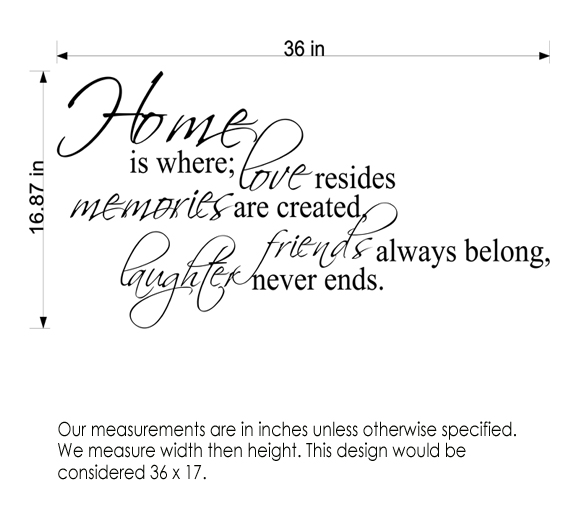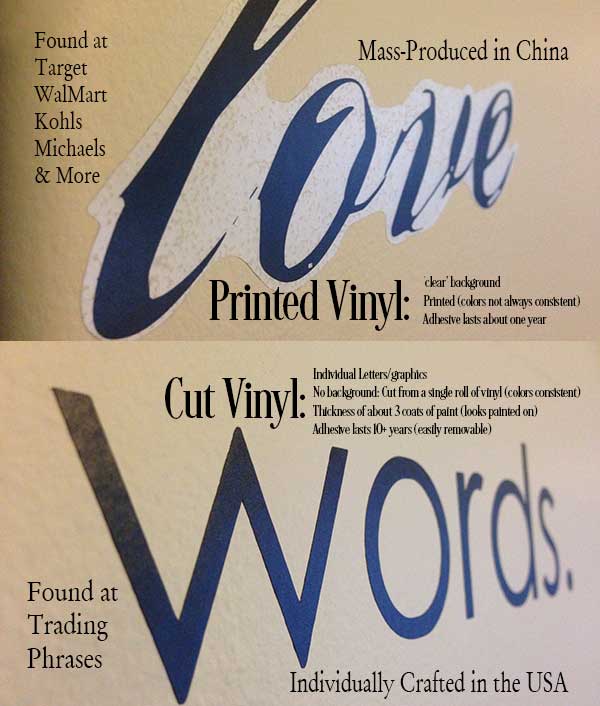New "Green" Paint Causes Problems

Posted: 03-11-2013 03:26 PM
Views: 22540
Synopsis: At Trading Phrases we are ALL about going green and helping the environment, but new "Green" paints may pose a problem for your decals!
|
This article can be found HERE orginally.
Trends in interior decor are making it harder to apply wall graphics & letters. As noted in a previous article, new high end with stain blockers pose a problem for vinyl adhesion. Interior wall graphics marketers have a new nemesis in the form of “green” paint. Not emerald green or hunter green. We mean “green” as in environmentally friendly. A new kind of interior latex is coming to market that is sold as “zero VOC” or “VOC free” paint. It sounds like a good thing, and may indeed hold benefits for air quality and public health. But it’s detrimental to the health of some of our customers because they’re pulling their hair out trying to understand why their wall graphics are failing. What is VOC free paint, and why is it ruining wall graphics? Here are the details as we know them.
What is VOC free paint? To understand what VOC free paint is, obviously, we have to understand VOCs. The term VOC is an acronym for Volatile Organic Compounds. These compounds are called volatile because they are chemically unstable and degrade over time. VOCs are also found in a great many things including solvent based inks, plastics, and adhesives. The out-gassing of these compounds in newly manufactured vehicles produces what is commonly known as “that new car smell.” VOCs are also found in interior and exterior house paint. As the paint dries, these compounds are given off in the fumes. This curing process generally takes three or four weeks. This is why freshly painted walls cannot be decorated with vinyl until they’re completely cured. The VOCs get trapped under the vinyl and begin to chemically interact with the adhesive, causing it to fail, or become permanently fused to the wall. Given this problem, one might think that VOC free paint would be an improvement designed to aid graphics installation. Not quite. The reason for VOC free paints is concern over the long term health effects of exposure to these fumes as they outgas. VOC free or “zero VOC” paint is being marketed as a healthier and more environmentally friendly alternative to paints that contain formaldehyde and other volatile organic compounds. Click here for more information from the American Lung Association about products that contribute to the indoor accumulation of VOCs. Paints currently marketed as Zero VOC or VOC free include Yolo Colorhouse, Behr Premium Plus Enamel Low Luster, Benjamin Moore’s Natura® paint, and Glidden Spred®. Sherwin Williams offers several such paints including GreenGuard Emerald Interior Acrylic Latex, Harmony, Pro Industrial Zero VOC Waterborne Catalyzed Epoxy, Pro Industrial Zero VOC Acrylic Coating, and ProMAR 200 & 400 Interior Latex paint. What’s the problem? Why Now? Why are they causing such a problem now? The timing is due in part to the growing movement toward more sustainable and healthy products, which is a good thing. What has made it a problem for sign and graphics installers recently is a new program initiative from HGTV called “HGTV Green Home”. As more people are exposed to the Green Home message and choose to remodel with Zero VOC interior paint, wall graphics installations failures are increasing. What is it about VOC Free paint that stymies wall vinyl? The answers are still coming, but ORACAL has begun research into the problem. Here’s a brief summary of their findings, shared with us by Josh Culverhouse of ORACAL tech support. Removable, plotter cut wall graphics, produced with ORACAL 631 matte vinyl, are releasing from the application tape to the wall much more easily on traditional formula egg-shell or satin finish latex paints, as opposed to the Zero VOC versions. Printed contour cut and wall mural type removable wall graphics (produced with ORAJET 3268 or 3268 wall printable vinyl) often will begin to drape or fall off, shortly after application to a wall that’s been finished with a Zero VOC latex paint. These failures are a combination of low adhesion levels, incompatibility with the Zero VOC latex paint, and the added weight of these types of graphics due to heavy ink loads. Vinyl films with a permanent do perform slightly better, but not as well as they would when applied to a traditional formula latex paint finish. What can you do? It’s not entirely hopeless. ORACAL reports that removable vinyl wall graphics will adhere to latex versions of Zero VOC paints, but it takes a lot more work to release the graphic to the wall. The vinyl must then be burnished into the slightly “stippled” texture of these paints to expedite the adhesion levels. Testing continues, so these are all considered preliminary observations and suggestions. Recommended surfaces Until a more effective solution comes to market, it is best to avoid selling wall graphics to commercial or residential customers who’ve opted for VOC Free paint. ORACAL 631 works best on flat enamel painted walls that have been allowed to cure for at least three weeks. ORACAL recommends applying 631 to smooth, semi-gloss or gloss enamel paint. If possible, avoid matte finish Latex paints and paints that contain anti-graffiti agents or stain blockers. For more details about the best methods for successful wall graphics installation using ORACAL 631, please click here to download the updated removable vinyl instruction sheet. You may be wondering why it seems to be so difficult to make these graphics stick. As we’ve noted often in the past, these vinyl films were originally designed for temporary trade show graphics: application on smooth, flat, vinyl-friendly surfaces. They were not engineered for installation on painted interior walls. So if you’re selling these, keep that in mind. As home decor trends change and new types of paints come to market, it behooves you to find out what kind of wall textures and paints your customer have. Steer them toward vinyl-friendly paints when you can. When you can’t, do your best to set their expectations accordingly. |












